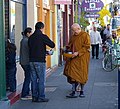Pindapata

Piṇḍapāta or piṇḍacāra is a Pali term used to refer to the Buddhist monastic practice of almsround to the laity to receive almsfood and other necessities.[1][2]
In Japanese Buddhism, this practice is also known as Takuhatsu (托鉢).[3]
Theravāda
[edit]In Theravāda Buddhism, the practice is referred to by the Pāli term piṇḍacāra (𑀧𑀺𑀡𑁆𑀟𑀘𑀸𑀭).[4] Monks or nuns on piṇḍacāra go around town on foot with their almsbowl under their outer robe and make themselves available to the laity to receive almsfood (𑀧𑀺𑀡𑁆𑀟𑀧𑀸𑀢, piṇḍapāta).[1][2]
Owing, however, to the precarity inherent in almost all aspects of Theravāda monastic life,[5] there is no guarantee of collecting enough food for the day, if any at all. This precarity is particularly observable outside the Indosphere,[6][7] or even within it in times of societal or systemic crisis.
-
Pindapata around Bodhigiri Vihāra, Balerejo, Wlingi, Blitar, East Java, Indonesia
-
Ṭhānissaro, an American monk, practicing piṇḍacāra by receiving piṇḍapāta in Portland, Oregon, United States
-
Monks and nuns of Empty Cloud Monastery on piṇḍapāta in West Orange, New Jersey, United States
-
Piṇḍapāta at Dhammagiri Forest Hermitage, Brisbane, Australia
-
Piṇḍapāta at Dhammagiri Forest Hermitage, Brisbane, Australia
-
Piṇḍapāta in Myanmar
-
Piṇḍapāta in Luang Prabang, Laos
-
Piṇḍapāta in Si Phan Don, Laos
-
Two monks performing piṇḍapāta on Street 172, Phnom Penh, Cambodia
-
Piṇḍapāta in Ladakh, India
-
Piṇḍapāta next to CentralWorld, Bangkok, Thailand
-
Piṇḍapāta on a small island in Thailand
Mahāyāna
[edit]In the practice of takuhatsu, monks travel to various businesses and residences to chant sutras in Sino-Japanese (thus generating merit) in exchange for donations of food and money.
Monks generally wear traditional takuhatsu clothes reminiscent of medieval Japanese garb and wear the names of their monasteries on their satchels to confirm their identities. This system is used by Zen monks in training to beg for their food, and is generally done in groups of ten to fifteen. The group walks through a street in single-file, chanting Hō (法, dharma), and the faithful gather to fill their alms bowls. This is the monks' offering of the Dharma and their lives of guardians of the Dharma to the people. According to Zen tradition, the givers should be grateful.[8]
-
A Japanese monk practicing takuhatsu on a Tokyo street, 2013
-
Takuhatsu practice in Tsutsujigaoka, Chofu, Tokyo
-
The practice of takuhatsu at Zuioji Temple
-
Takuhatsu practice in Kyoto, Japan
-
Takuhatsu practice at Hantaji Temple, Matsuyama
-
Mahāyāna nuns on alms round at Sunnataram Forest Monastery in Bundanoon, New South Wales, Australia
References
[edit]- ^ a b "Piṇḍapāta in Detail". Pālēlāi Buddhist Temple.
- ^ a b "Piṇḍacāra: Going on Almsround". Nāḷandā Buddhist Society. 2012-08-29.
- ^ "Takuhatsu". A Dictionary of Buddhism. Oxford University Press. 2004. ISBN 9780198605607.
- ^ "Generosity Begins with Me!". Nāḷandā Buddhist Society. 2012-04-28.
- ^ Gavesako (2003). "The Value of Piṇḍapāta".
- ^ Mills, Lawrence (1964). The Blessings of Piṇḍapāta. Kandy, CP: Buddhist Publication Society.
- ^ Dinsmore, John David (2019). Through the Looking Glass: An American Buddhist Life.
- ^ Reps & Senzaki, p. 48



















